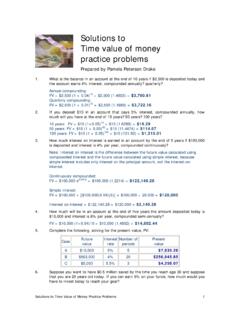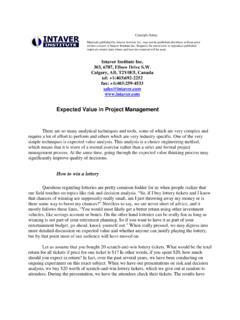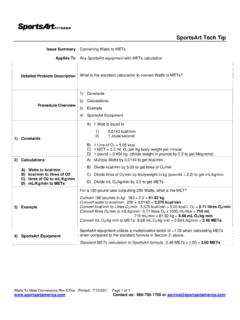Transcription of Value for Money in Health Spending - OECD.org
1 Value for Money in Health Spending OECD 201021 Chapter 1 How Much is Too Much? Value for Money in Health SpendingThis chapter starts with a look at recent trends focusing on the last decade and ahalf in Health Spending and its components. The main drivers behind healthexpenditure growth are then discussed and, on the basis of this, possible futurespending pressure. The chapter then presents a brief assessment of the currentmacroeconomic situation facing OECD countries, drawing on the latest projectionsof countries fiscal positions and concludes with a discussion of recent evidence onthe degree of system inefficiency, suggesting that there is scope for addressingsustainability, financial or economic, by improving the efficiency of resource use tothat of the best HOW MUCH IS TOO MUCH?
2 Value FOR Money IN Health SPENDINGVALUE FOR Money IN Health Spending OECD 2010221. IntroductionOECD countries have made tremendous strides in improving population Health overrecent decades. Life expectancy at birth has increased, rising on average by ten yearsbetween 1960 and 2008. Gains at older ages have been even more dramatic. Today, a womanaged 65 can expect to live a further 20 years, and a man an additional 17 years. Althoughsocio-economic inequalities in Health status and access to care remain, reductions in childmortality and gains in population Health have continued to improve at a steady pace overthe past few decades (OECD, 2009a).
3 Levels of morbidity have fallen and infant mortality isnow five times lower today than it was in 1960. Part of these achievements can be put down to increased incomes and higher levels ofeducation. But a good portion has originated in the improvements in Health care change has brought better treatments and benefitted a wider section of thepopulation. For example, improvements in anaesthesia combined with non-invasivesurgery have meant that a greater number of older patients can be operated with less painand faster recovery than before.
4 Even in the past few years, huge improvements have beenmade in the treatment of stroke and other heart diseases, reducing mortality rates fromthese diseases dramatically. Public Health has also improved with higher levels ofimmunisation which has limited the spread of communicable systems have also evolved such that almost all countries have some form ofpublic or private insurance covering the risk of ill Health and high medical costs and accessto quality Health care has also improved. Less developed OECD countries have progressedin this area: Mexico and Turkey have increased insurance cover for the poorest groups ofthe population.
5 The historic Health reforms in the United States pave the way towardsmandated Health insurance for a wider share of the population. Improvements in medical-practice standards have been accompanied by efforts to reduce the provision ofinappropriate services and address shortcomings in the quality of Health systems are more effective, provide higher quality care, and have givenaccess to Health care to a larger share of the population than ever before. However, theseachievements have not come cheaply. Countries have confronted steady increases in thecost of Health care Spending over recent decades.
6 Total Health expenditure has nowreached 9% of GDP for the average OECD country with seven countries having a ratio of over10% (the United States, France, Switzerland, Austria, Germany, Canada and Belgium),compared with only three countries a half decade before. How much and what theyconsume in terms of Health care, as well as the rate of growth of Health Spending , variesenormously between countries as do the Health to the future, OECD countries will continue to face upward pressures onhealth Spending from a number of factors including demographic change, advances inmedical care technology and the growing expectations from patients and the electorate atlarge.
7 Since the public purse finances the vast majority of Health -related Spending in most1. HOW MUCH IS TOO MUCH? Value FOR Money IN Health SPENDINGVALUE FOR Money IN Health Spending OECD 201023countries, these increasing demands for Health services need to be seen in the currentcontext of increasingly constrained public , then, is the challenge for Health systems. When those who pay for Health look atwhat they get for their Money , can they be sure that they are getting Value for their Money ?Talking of Value for Money in Health expenditure is sometimes taken as a coded wayof talking about cuts in Spending .
8 This is not what is meant in this publication. It is ratherused in the sense of whether the benefits of Spending exceed the costs. Increased Value formoney can come from reduced Spending , it is true, but it can come equally from deliveringmore of the things that we Value in our Health are as many different frameworks for looking at the benefits or objectives of thehealth system as there are analysts looking at the topic,1 but they are all in reality very OECD analyses Health care systems on the basis of four main pillars or objectives: The first pillar is whether Health care systems provide widespread access to Health careservices and adequate insurance against the cost of care for the population at large in anequitable manner.
9 The second pillar relates to whether the care provided is of high quality and whetherhealth care providers are responsive to patient/consumer needs. The third pillar considers whether the cost of the Health care system can be sustained overthe longer haul given political constraints and choices imposed by the total governmentfinancial resources and the other calls on the public purse such as education. The fourth pillar is whether care is provided in an efficient and effective first two objectives concern how well Health care systems are performing in termsof Health care supply and whether the provision of care services are of high quality andadapted to patient needs.
10 The third and fourth criteria consider whether resources areadequate and being put to good , though not included in most listings of the objectives of the healthsystem, it is also true that Health is a significant sector of the economy, and is one that isusually under some form of public control. This means that the Health system cansometimes be used by governments as an instrument in wider economic policies. Forexample, in the recent recession, Spending on Health has acted as an automatic stabiliserto the economy, and has been a source of jobs growth when most other sectors have beenin emphasis placed on Health policy goals by individual governments can of coursevary in importance both over time and between countries for very good reasons.
















